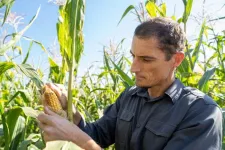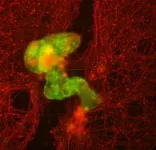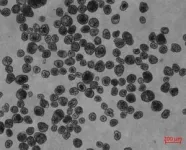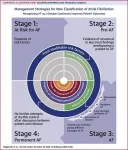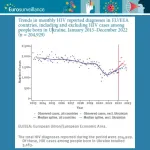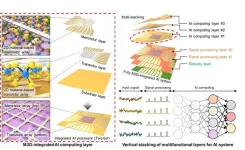(Press-News.org) Maize is one of the world’s most widely grown crops. It is used for both human and animal foods and holds great cultural significance, especially for indigenous peoples in the Americas. Yet despite its importance, the origins of the grain have been hotly debated for more than a century. Now new research, published Dec. 1 in Science, shows that all modern maize descends from a hybrid created just over 5000 years ago in central Mexico, thousands of years after the plant was first domesticated.
The work has implications both for improving one of the world’s most important crops and for understanding how the histories of people and their crops influence each other.
“It’s a new model for the origins and spread of maize, and how it became a staple across the Americas,” said Jeffrey Ross-Ibarra, professor in the Department of Evolution and Ecology at the University of California, Davis and senior author on the paper.
For the last few decades, the consensus has been that maize (Zea mays) was domesticated once from a single wild grass – called teosinte -- in the lowlands of southwest Mexico about 9,000 to 10,000 years ago. Known as corn in the United States, maize is not only a staple of diets around the globe, but also can be processed into sweeteners,ethanol fuel and other uses.
More recently, though, it’s become clear that the genome of modern maize also contains a hefty dose of DNA from a second teosinte that grows in the highlands of central Mexico.
Ross-Ibarra and collaborators in the U. S., China and Mexico analyzed the genomes of over a thousand samples of maize and wild relatives. They found that about 20 percent of the genome of all maize worldwide comes from this second highland teosinte.
New model for spread of maize
These new findings suggest that, though maize was domesticated around 10,000 years ago, it was not until 4,000 years later, when it hybridized with highland teosinte, that maize really took off as a popular crop and food staple. This is also supported by archaeological evidence of the increasing importance of maize around the same time.
The new crop spread rapidly through the Americas and later worldwide. Today, about 1.2 billion metric tons is harvested each year globally.
The hunt for why highland teosinte enabled maize to become a staple is still underway, Ross-Ibarra said. The researchers did find genes related to cob size – perhaps representing an increased yield potential – and flowering time, which likely helped maize, a tropical crop, to grow at higher latitudes with longer days.
Hybridization may also have brought “hybrid vigor,” where a hybrid organism is more vigorous than either of its parents. The researchers observed that genomic segments from highland teosinte contained fewer harmful mutations than did other parts of the genome.
While the initial hybridization may have been accidental, it’s likely that indigenous farmers recognized and took advantage of the novel variation introduced from highland maize, Ross-Ibarra said. Even today, he said, “If you talk to Mexican farmers, some will tell you that letting wild maize grow near the fields makes their crops stronger.”
NSF grant
A team led by Ross-Ibarra with Professor Graham Coop at UC Davis, archaeologists at UC Santa Barbara and geneticists at Swedish University of Agricultural Sciences was recently awarded a $1.6 million grant from the National Science Foundation to study the co-evolution of humans and maize in the Americas. They will use genetics to look at how humans and maize spread across the continent and how populations of both maize and humans grew and shrank as they interacted with each other.
“We will incorporate human genetic data, maize genetics and archaeological data in an effort to answer many of the questions raised by our new model of maize origins,” Ross-Ibarra said.
Coauthors on the Science paper are: at UC Davis, Erin Calfee, Sowmya Mambakkam, Mitra Menon, Carl Veller and Daniel Runcie; Ning Yang, Yuebin Wang, Minliang Jin, Lu Chen, Songtao Gui, Wenqiang Li, Jingyun Luo, Shenshen Wu, Siying Wu, Yingjie Xiao and Jianbing Yan, Huazhong Agricultural University, Wuhan; Xiangguo Liu, Jilin Academy of Agricultural Sciences; Miguel Vallebueno-Estrada, Laboratorio Nacional de Genómica para la Biodiversidad, CINVESTAV Irapuato, Guanajuato, México; Brian Dilkes, Purdue University; Xingming Fan, Yunnan Academy of Agricultural Sciences; Thomas Harper, Pennsylvania State University; Samantha Snodgrass, Iowa State University; Douglas Kennett, UC Santa Barbara; Yanli Lu, Sichuan Agricultural University; Xiaohong Yang, China Agricultural University; and Michelle C. Stitzer, Cornell University.
The work was supported by grants from the National Natural Science Foundation of China, the U.S. National Science Foundation and the U.S. Department of Agriculture.
END
A mixed origin made maize successful
2023-11-30
ELSE PRESS RELEASES FROM THIS DATE:
Discovery of planet too big for its sun throws off solar system formation models
2023-11-30
UNIVERSITY PARK, Pa. – The discovery of a planet that is far too massive for its sun is calling into question what was previously understood about the formation of planets and their solar systems, according to Penn State researchers.
In a paper published online today (Nov. 30) in the journal Science, researchers report the discovery of a planet more than 13 times as massive as Earth orbiting the “ultracool” star LHS 3154, which itself is nine times less massive than the sun. The mass ratio of the newly found planet with its host star is more than 100 times higher than that of Earth and the sun.
The finding reveals the most massive known ...
Early rhythm control, lifestyle modification and more tailored stroke risk assessment are top goals in managing atrial fibrillation
2023-11-30
The American College of Cardiology (ACC) and the American Heart Association (AHA), along with several other leading medical associations, have issued a new guideline for preventing and optimally managing atrial fibrillation (AFib). The guideline was jointly published today in the Journal of the American College of Cardiology and Circulation.
Atrial fibrillation, or AFib, is the most common type of heart rhythm disorder (arrhythmia), affecting over 6 million Americans, and the number is expected to double by 2030. AFib causes a variety of symptoms, including fast ...
Carbon dioxide becomes more potent as climate changes, study finds
2023-11-30
Embargoed: Not for Release Until 2:00 pm U.S. Eastern Time Thursday, 30 November 2023.
A team of scientists found that carbon dioxide becomes a more potent greenhouse gas as more is released into the atmosphere.
The new study, led by scientists at the University of Miami Rosenstiel School of Marine, Atmospheric, Science, was published in Science and comes as world leaders meet in Dubai, United Arab Emirates, this week for the United Nations Climate Change Conference COP28.
“Our finding means that ...
Researchers extend non-line-of-sight imaging towards longer wavelengths
2023-11-30
WASHINGTON — Emerging technologies for non-line-of-sight imaging can detect objects even if they are around a corner or behind a wall. In new work, researchers use a new type of detector to extend this method from visible light into near and mid-infrared wavelengths, an advance that could be especially useful for unmanned vehicles, robotic vision, endoscopy and other applications.
“Infrared non-line-of-sight imaging can improve the safety and efficiency of unmanned vehicles by helping them detect and navigate around obstacles that are not directly visible,” said Xiaolong Hu from Tianjin University in China. His team collaborated with a group ...
EU/EEA: HIV diagnoses rise for the first time in a decade
2023-11-30
Across the 30 countries of the European Union and European Economic Area (EU/EEA), 22,995 new HIV diagnoses were reported in 2022. Almost every second new HIV diagnosis (49%, n=11,103) was among migrants, i.e. among people who were not born in in the country they were diagnosed in. born abroad from the country of their diagnosis.
In the aftermath of Russia’s invasion of Ukraine in 2022, more than 4 million Ukrainians took refuge in countries of the European Union and European Economic Area (EU/EEA). In a rapid communication published in Eurosurveillance prior to World AIDS Day 2023 on 1 December, Reyes-Urueña et al. look at most recent surveillance data ...
2D material reshapes 3D electronics for AI hardware
2023-11-30
Multifunctional computer chips have evolved to do more with integrated sensors, processors, memory and other specialized components. However, as chips have expanded, the time required to move information between functional components has also grown.
“Think of it like building a house,” said Sang-Hoon Bae, an assistant professor of mechanical engineering and materials science at the McKelvey School of Engineering at Washington University in St. Louis. “You build out laterally and up vertically to get more ...
George Demetri, MD, of Dana-Farber earns Lifetime Achievement Award in Medicine from Stanford University School of Medicine
2023-11-30
Boston – George Demetri, MD, director of the Sarcoma Center at Dana-Farber Cancer Institute, is being awarded the prestigious J.E. Wallace Sterling Lifetime Achievement Award in Medicine from the Stanford Medicine Alumni Association (SMAA). Demetri, an alumnus of the Stanford University School of Medicine, Class of 1983, will be honored at a dinner held on the Stanford University School of Medicine campus on December 4, 2023.
“Dr. Demetri is a leader in developing targeted therapeutics for cancer and has been pivotal in advancing oncology treatments ...
Snake skulls show how species adapt to prey
2023-11-30
By studying the skull shapes of dipsadine snakes, researchers at The University of Texas at Arlington have found how these species of snakes in Central and South America have evolved and adapted to meet the demands of their habitats and food sources.
The research, conducted in collaboration with colleagues at the University of Michigan, was published in the peer-reviewed journal BMC Ecology and Evolution.
“We now have evidence that this group of snakes is one of the most spectacular and largest vertebrate adaptive radiations currently known to science,” said Gregory Pandelis, collections manager at UTA’s Amphibian and Reptile Diversity ...
IU researchers develop new brain network modeling tools to advance Alzheimer's disease research
2023-11-30
INDIANAPOLIS—Indiana University researchers are collaborating on a novel approach to use neuroimaging and network modeling tools—previously developed to analyze brains of patients in the clinic—to investigate Alzheimer’s disease progression in preclinical animal models.
The research team, led by Evgeny Chumin, PhD, a postdoctoral research fellow in the College of Arts and Sciences' Department of Psychological and Brain Sciences at IU Bloomington, and Paul Territo, PhD, professor of medicine at the IU School of Medicine, published their findings in Alzheimer’s & Dementia: The Journal of ...
Sea fireflies synchronize their sparkle to seek soulmates
2023-11-30
ITHACA, N.Y. -- In sea fireflies’ underwater ballet, the males sway together in perfect, illuminated synchronization, basking in the glow of their secreted iridescent mucus.
“It’s extreme,” said Nicholai M. Hensley, a postdoctoral fellow in the Department of Neurobiology and Behavior in the College of Arts and Sciences. “It’s an illustration of convergent evolution and a striking example of synchronized bioluminescent mating displays. The males are putting it all out on the dance floor. It’s a big bright display.”
Hensley is the lead author of new research unwrapping the vivid mating ...
